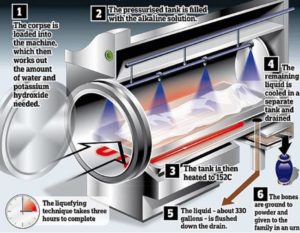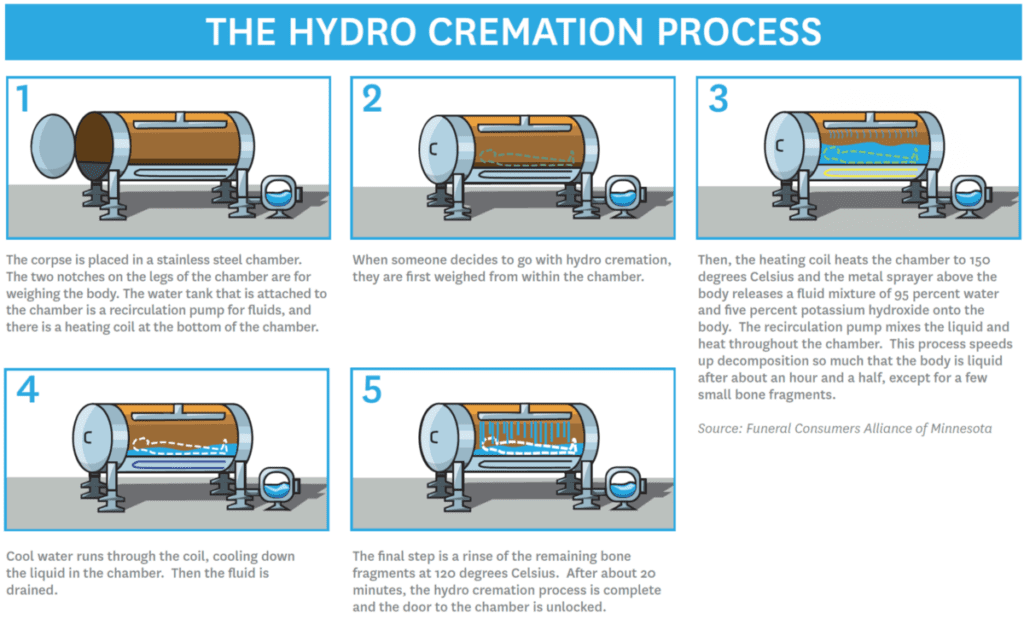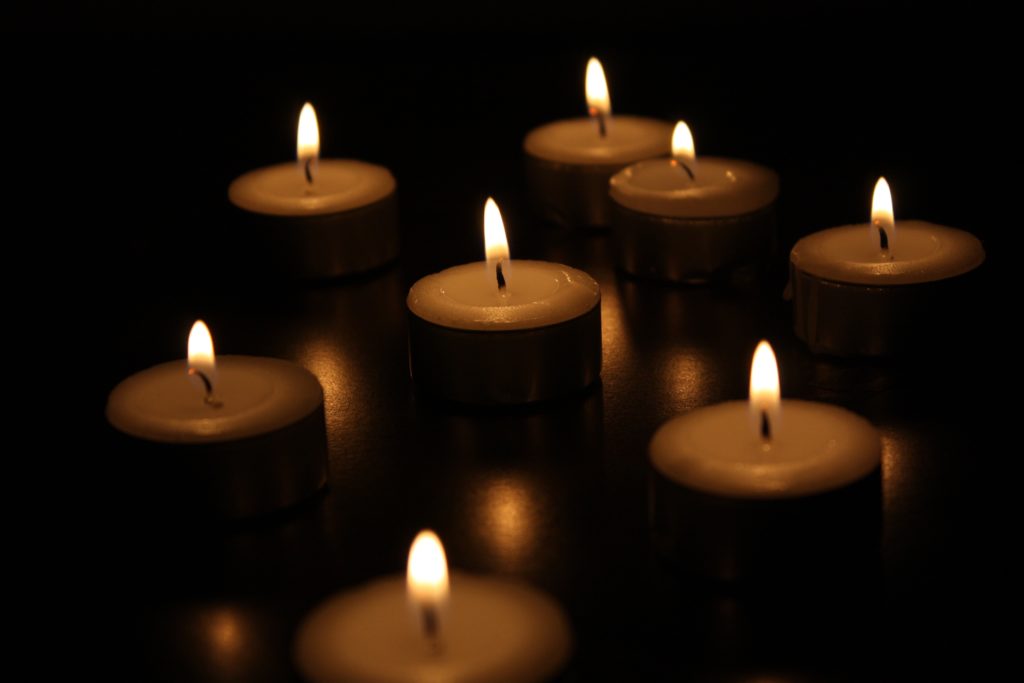No products in the cart.
Traditionally, cremation is a process that uses a flame to reduce an individual’s remains to ash; however, the Merriam-Webster definition of cremation is “the process of reducing a dead body to mostly tiny bits of bone resembling ash.” While the definition does go on to say that the process involves exposure to flame and intense heat, it also mentions that there are other forms of cremation or alternatives such as alkaline hydrolysis, also known as hydro cremation or flameless cremation.
What exactly is hydro cremation?
The technique of hydro cremation, also known as alkaline hydrolysis or water cremation, varies from that of traditional cremation. The difference between the two items lies in the method. The first makes use of fire, while the second makes use of water.

To convert human remains to ash, traditional cremation employs high-temperature fire in a dedicated chamber. Water, pressure, heat, and a strongly basic (pH 14) ingredient are used in hydro cremation. Soft tissues are dissolved by a specially developed machine, leaving only bone pieces to be converted into ash.
As a strategy to communicate the overall notion of alkaline hydrolysis to the consumer market, the word “cremation” has been ascribed incorrectly to it. The linkage also serves to divert attention away from the process’s possible ‘ick factor.’
Proponents see hydro cremation as a green burial option and a long-term alternative to standard embalming procedures and cremation. Concerns about the safety of discharging hydro-cremation effluent into municipal water supplies, as well as a perceived lack of regard for the human body, have been raised by critics. Because it is such a novel practice and is only utilized in a few areas, the impact of broad use on pollution or public health is unknown.
What is the hydro cremation procedure?
 Hydro cremation was initially created to securely dispose of animal remains following exposure to diseases such as Mad Cow Disease. For decades, the technique has been employed in laboratories all around the world. With this less-than-pleasant beginning, bio-cremation, or resomation as it is often called, has had a difficult time gaining widespread acceptance.
Hydro cremation was initially created to securely dispose of animal remains following exposure to diseases such as Mad Cow Disease. For decades, the technique has been employed in laboratories all around the world. With this less-than-pleasant beginning, bio-cremation, or resomation as it is often called, has had a difficult time gaining widespread acceptance.
According to Village Memorial BlogSpot, the procedure entails the following steps:
- The body is housed in a specially designed steel vessel.
- Approximately 80 liters of an alkaline solution of water and potassium hydroxide are added.
- After that, the vessel is heated to around 300 degrees.
- Soft tissues are dissolved into liquid after two to three hours.
- The leftover bone pieces are pulverized into fine white ash before being given to the family.
Funeral Consumers Alliance of Minnesota (“FCA”) provides a more extensive, scientific explanation on their website:
The deceased corpse is placed in a pressured stainless steel chamber with water (95%) and alkali (5%), and the temperature is increased to 350 degrees. Water, alkali, heat, and pressure are circulated throughout the body, causing a process that accelerates the disintegration of soft tissues. (Translation: it entirely dissolves everything but bone pieces – skin, organs, etc.) The resultant sterile solution is evacuated from the pressure chamber, leaving behind soft bone fragments. The wastewater treatment system recycles the sterile solution.
The Village Memorial blog compares the process to a sped-up version of what happens in nature when the corpse decomposes. “By mimicking a body’s natural chemical decomposition process, it breaks down the human chemical makeup of 65 percent oxygen, 18 percent carbon, 10 percent hydrogen, 3 percent nitrogen, 1.5 percent calcium, 1 percent phosphorus, and 1.5 percent total of remaining additional elements, reducing CO2 emissions in the process.” Potassium hydroxide is the active chemical agent used, reducing tissues into amino acids, small peptides, sugars, nutrients, and soap. For instance, the entire decomposition of a person can take up to 25 years if permitted to proceed naturally, rather than two to three hours.
What remains after hydro-cremation?
As previously stated, soft tissue has been liquefied. The ashes left over from the process are comparable to those leftover after a typical cremation, although they are greater in volume and more finely grained. Whereas ordinary cremation yields a gritty brownish residue, hydro cremation yields a pristine white powder.
The end result is described by the FCA as “bone ash, although the ash is whiter than flame cremation and of a finer consistency, almost like flour.” Green cremation retains more bone fragments than flame cremation by more than 20%. If you choose Green Cremation, make sure the container (urn or otherwise) you pick is large enough to handle the extra amount of ash.”
Choosing a Cremation Urn Following Hydro Cremation
It is critical to emphasize the significance of selecting a bigger cremation urn to house the ashes following hydro cremation over regular cremation.
When finished, the method generates up to 20% more bone ash than ordinary cremation. According to the How Stuff Works Science website, an average human body may create three to nine pounds of ash, depending on the bone form and weight. For a typical cremation, an acceptable technique of measuring volume is one cubic inch of ash per pound of body weight. Factor in an additional 20% for hydro cremation.
What are the advantages of hydro cremation as opposed to traditional cremation?
Many reasons are given by supporters of hydro cremation for adopting this mode of disposal. Most importantly, it is a more environmentally friendly option to being embalmed and buried. Village Memorial lists the following advantages:
- There are no harmful mercury emissions.
- Far less energy is utilized than in typical cremation.
- Caskets are not to be burned.
- Cleaner – No toxins or dioxins are released into the environment.
- Cremation produces less carbon dioxide than incineration.
- The individual’s bone ash remnants are completely unique.
- Soil chemistry is improved by byproducts.
- The bone ash (Calcium Phosphate) is totally neutralized, sterile, and devoid of illness and pathogens.
The FCA refers to hydro cremation as “green cremations,” and its website claims the following advantages:
- The carbon footprint has been reduced by more than 75%.
- It consumes one-eighth the energy of flame-based cremation.
- Pacemakers and other medical equipment, unlike flame-based cremation, do not need to be removed prior to the process.
- The mercury in dental amalgam is retained and recycled rather than evaporated.
- More bone pieces are preserved than with flame cremation.
What is the best way to locate a service provider?
There is widespread misunderstanding regarding how alkaline hydrolysis cremation works. As a result, the procedure is not generally available at the moment. Legal precedents and social acceptance of new death traditions are sometimes slow to alter.
“Alkaline hydrolysis is now authorized in just eight U.S. states,” according to the science, technology, and design site Gizmodo. Despite being one of the most affordable and ecologically friendly methods of dealing with a [body], it is not an option for the majority of us. … Currently, the procedure is permitted in Colorado, Florida, Illinois, Kansas, Maine, Maryland, Minnesota, and Oregon.”
According to the FCA’s website, Minnesota was the first (legalized in 2003) and one of just a few jurisdictions where alkaline hydrolysis is available to the public. The Rochester-based Mayo Clinic refers to hydro cremation as bio cremation. Bio cremation is now available in Minnesota solely via Bradshaw Funeral and Cremation Services in Stillwater and the Mayo Clinic in Rochester.
If you reside in one of the other seven states (mentioned above) where hydro cremation is accessible, you may learn about nearby venues by conducting a fast Internet search for service providers in your state. Alkaline hydrolysis cremation is gradually becoming more popular, and regulations are evolving to accommodate this approach, therefore there will most certainly be a lot of change in the near future.
What is the price?
Prices will vary greatly amongst providers, so be careful to investigate locally if you choose to go this way. According to the Funeral Consumers Alliance of Minnesota,
The cost of a basic green cremation (no on-site ceremony) is $2,395, which is three times the lowest Direct Cremation fee in the Twin Cities Metro region but less than what other funeral homes charge. (One small-town funeral home in southern Minnesota costs $4,320 for Direct Cremation, one of the state’s highest fees.) Some analysts expect the price will fall as more funeral homes provide Alkaline Hydrolysis. However, due to the expensive expense of the Resomator, the stainless steel pressure chamber used for Alkaline Hydrolysis, many funeral homes are reluctant to include this option in their General Price Lists.
As previously stated, the cost of hydro cremation should decrease as the technology becomes more generally available and more broadly accepted by the general public. As hydro cremation becomes more commonly available, market forces will ultimately bring down costs, enabling increased competition among suppliers. However, for the time being, it is much more expensive than standard cremation but significantly less expensive than a traditional burial.
Is it governed by any laws?
Alkaline hydrolysis is now controlled on a state level, according to the Cremation Association of North America and the National Funeral Directors Association. This may alter in the future as acceptability grows. There hasn’t been a request for federal regulation because just eight states in the country use hydro cremation.
Cremation urns appropriate for cremation ashes following hydro cremation
The concern of whether the remains obtained after the process belonged to your loved one is never far from your mind. However, because just one body is ‘cremated’ at a time with hydro cremation, this uncertainty is removed.
There are several cremation urns that are cheap, attractively constructed, and interest-specific. Consider a showcase cremation urn, a scattering urn, or a biodegradable urn to be buried or planted with a tree. Your considerate decision will pay tribute to your loved one.


